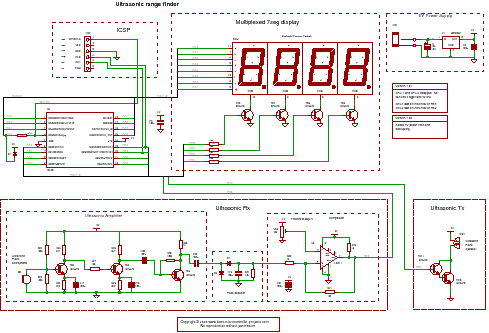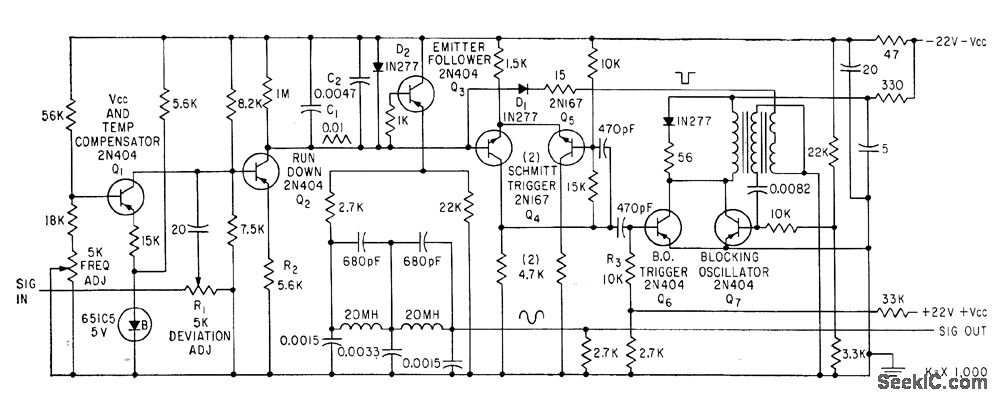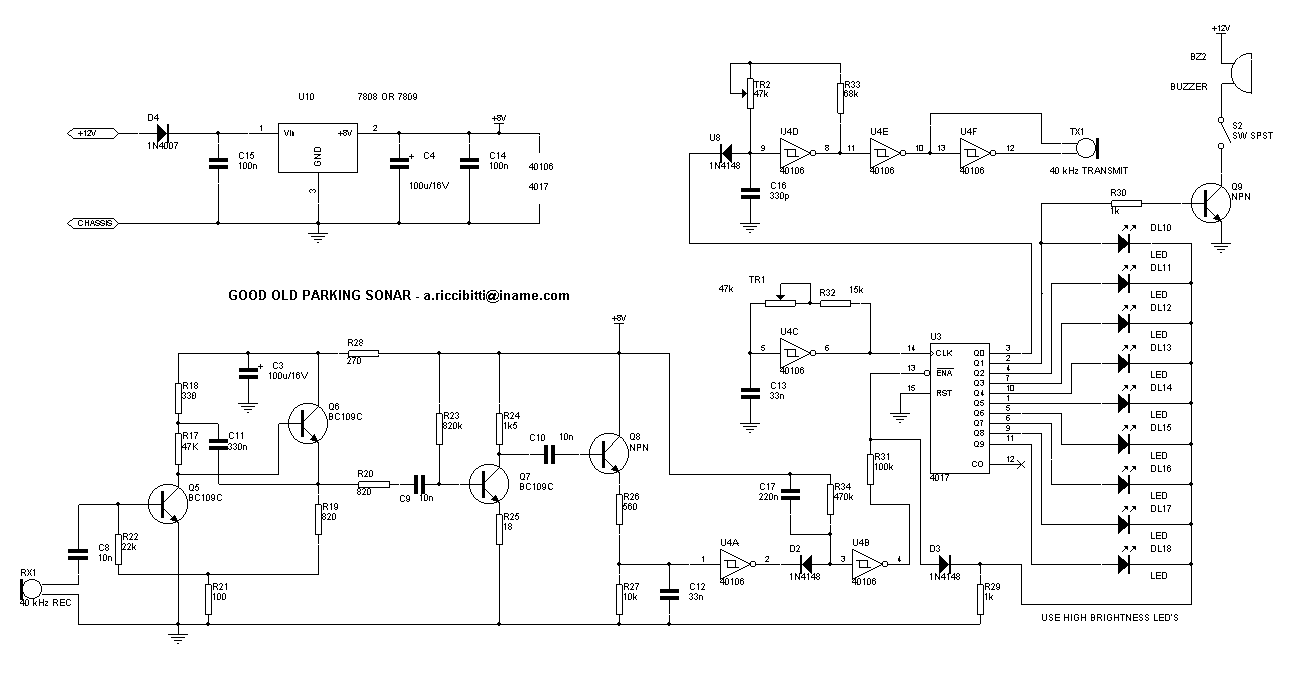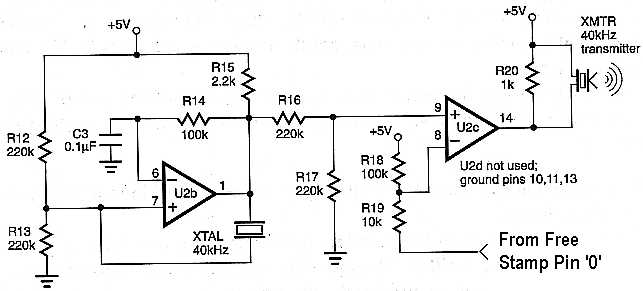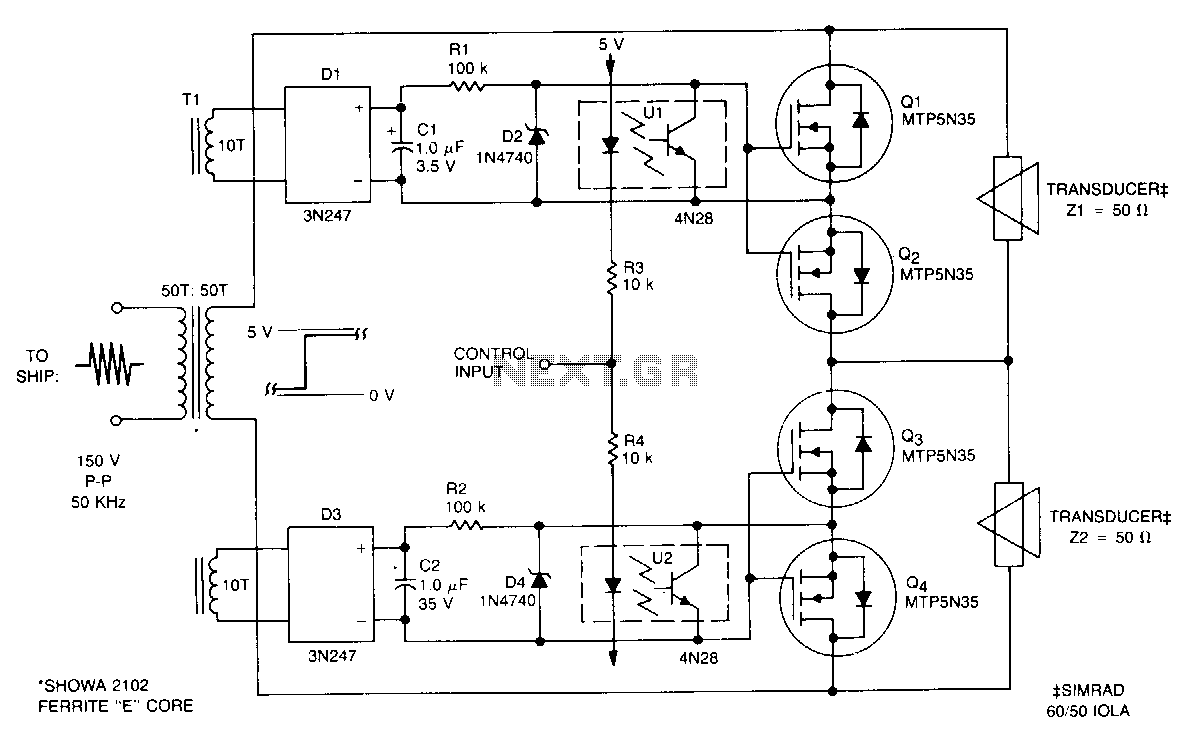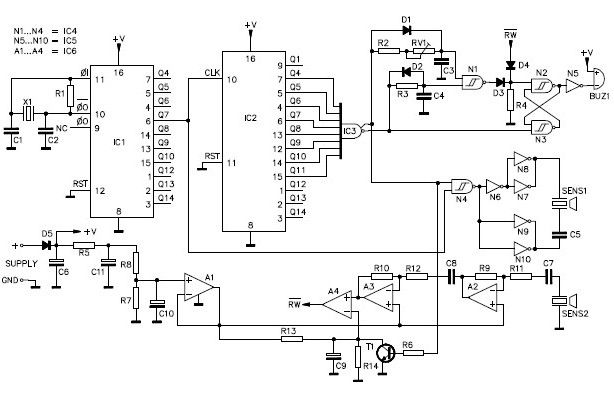
sonar
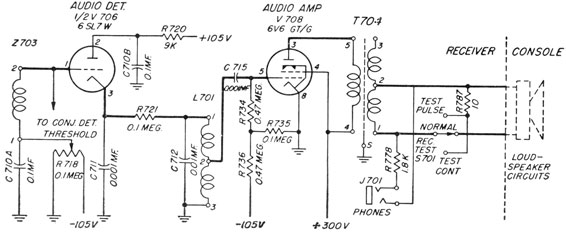
The receiving systems used with scanning-type echo-ranging equipment are dual-channel systems, which are essential in current video portrayal methods. Deviation indicators, which can be cathode-ray tubes or galvanometers, utilize either a sum-and-difference or a comparison receiving system. These systems measure the phase angle of the echo signal between two halves of a transducer that has been electrically split, allowing it to function as two independent hydrophones upon reception. When the appropriate circuits are employed, the phase angle can be converted into voltage differences, providing video portrayal that indicates the deviation from the correct target bearing, specifically isodepression deviation indication (DDI) or bearing deviation indication (BDI). Scanning systems employ conventional superheterodyne receivers—one for the video channel and another for the audio channel. The receiver's role in video portrayal is to supply brightening voltage to the grid of the cathode-ray tube, as the scanning and deflection voltages are generated outside the receiver circuits. The audio channels relay returning echoes to the operator to assist in target identification. The transducer used in scanning systems is keg-shaped and is mechanically and electrically divided into an even number of independent elements. In the QHB-1 model, there are 48 elements arranged so that each element covers an arc of 7.5° of the transducer's periphery. During transmission, a keying relay connects all elements in parallel, allowing sound power to be radiated in all directions simultaneously, while during reception, the elements are configured to form a sharp beam in the horizontal plane. The output from each element is connected through its individual preamplifier to its corresponding element on each of the two scanning switches. The video scanning switch operates at a constant rate and is controlled by a transformer that maintains a 1-to-1 ratio with it. The output of this transformer is responsible for positioning the electron beam of the cathode-ray indicator, ensuring synchronization in azimuth bearing with the scanning switch. Although the audio scanning switch and the video switch are mechanically and electrically identical, they serve different applications. The audio switch is positioned by a servo system and requires manual training to the desired bearing. The receiving system detailed in the subsequent paragraphs pertains to the QHB-1 scanning sonar equipment, selected for discussion due to its conventional video portrayal design, making it a representative system. The block diagram is illustrated in figure 7-1. The receiver-converter consists of separate video-channel and audio-channel receivers for signals from the respective scanning switches. A tunable oscillator provides frequency to the first mixers in both channels and to the converter, which generates the transmitted frequency. This oscillator designates the circuit as the unicontrol system, allowing a single control to tune both the receivers and the transmitter to the same frequency. Within the receiver-converter, a master fixed-frequency 65 kHz oscillator (not shown in figure 7-1) modulates a 90.5 kHz signal (arbitrarily selected) from the unicontrol oscillator, and the 25.5 kHz frequency difference is amplified in the transmitter power amplifier. The intermediate frequency (i-f) stages of both receiver channels are tuned to 65 kHz. The first mixer in the receiver channels automatically generates an intermediate frequency of 65 kHz by mixing the 25.5 kHz received signals with the 90.5 kHz output from the unicontrol oscillator. The frequency of the unicontrol oscillator can be adjusted from 87 to 94 kHz, resulting in a transmitted frequency variation from 22 to 29 kHz. The transducer operates within a frequency range of 24 to 27 kHz.
The QHB-1 scanning sonar system exemplifies advanced echo-ranging technology, integrating dual-channel receiving mechanisms that enhance target detection and identification. The dual-channel architecture allows simultaneous processing of video and audio signals, crucial for accurate portrayal of underwater environments. The phase measurement technique employed in the system enables precise determination of target location by analyzing the echo signal's phase shift between the two hydrophone-like elements of the transducer.
The keg-shaped transducer design, featuring 48 independent elements, ensures a comprehensive coverage of the surrounding area, facilitating omnidirectional sound radiation during transmission and focused sound reception during echo analysis. The ability to switch between these modes via a keying relay enhances operational flexibility and improves the system's responsiveness to varying underwater conditions.
The video and audio scanning switches operate in tandem, with the video switch providing real-time visual feedback to the operator, while the audio switch enhances situational awareness through auditory signals. The synchronization of the cathode-ray tube's electron beam with the scanning switch is critical for accurate visual representation of target deviations, allowing operators to make informed decisions based on the presented data.
Furthermore, the unicontrol oscillator's design simplifies frequency management, ensuring that both the transmit and receive circuits remain in harmony, which is vital for maintaining signal integrity. The tunable nature of the oscillator allows for adaptability across different operational scenarios, making the QHB-1 system a versatile tool in sonar applications.
Overall, the QHB-1 scanning sonar equipment represents a sophisticated integration of electronic components and signal processing techniques, providing a reliable and efficient means of underwater exploration and target identification.The receiving systems used with the scanning type of echo-ranging equipments are of the dual-channel type, which is required in present methods of video portrayal. Deviation indicators, which are cathode-ray tubes or galvanometers, use either a sum-and-difference or a comparison receiving system.
These systems are used to measure the phase angle o f the echo signal between the two halves of a transducer that has been electrically split so that, on reception, it acts as two independent hydrophones. When the proper circuits are used with these systems the phase angle can be translated into voltage differences, and the video portrayal is indicative of the deviation from the correct target bearing, that isodepression deviation indication (DDI) or bearing deviation indication (BDI).
Scanning systems use conventional superheterodyne receivers-one for the video channel and one for the audio channel. The only function of the receiver in the video portrayal is to furnish brightening voltage to the grid of the cathode-ray tube because the scanning and deflection voltages are developed outside the receiver circuits.
The audio channels are used to supply the returning echoes to the operator as an aid in identifying targets. The transducer used with scanning systems is keg-shaped and is mechanically and electrically divided into an even number of independent elements.
In the model QHB-1 there are 48 such elements located so that each element covers an arc of 7 ½ ° of the transducer`s periphery. On transmission, the keying relay connects all the elements in parallel so that sound power is radiated in all directions simultaneously, whereas on reception the elements are connected so as to form a sharp beam in the horizontal plane.
The output of each element is connected through its individual preamplifier to its corresponding element on each of the two scanning switches. The video scanning switch is driven at a constant rate and has a control transformer geared at a 1-to-1 ratio with it.
The output of this transformer controls the positioning of the electron beam of the cathode-ray indicator so that the electron beam synchronizes in azimuth bearing with the scanning switch. The audio scanning switch and the video switch are mechanically and electrically identical, but they differ in application.
The audio switch is positioned by a servo system and must be manually trained to the desired bearing. The receiving system described in the following paragraphs is that of the QHB-1 scanning sonar equipment.
The QHB-1 system was chosen for discussion because its method of video portrayal follows the conventional design and it can be considered a typical system. The block diagram is shown in figure 7-1. The receiver-converter includes separate video-channel and audio-channel receivers for the signals from the corresponding scanning switches.
In this system a tunable oscillator supplies a frequency to the first mixers in both channels and also to the converter, which produces the transmitted frequency. This oscillator identifies the circuit as the unicontrol system because it enables a single control to tune the receivers and the transmitter at the same frequency.
In the receiver-converter a master fixed-frequency 65 kc oscillator (not shown in figure 7-1) modulates a 90. 5 kc signal (arbitrarily selected) from the unicontrol oscillator, and the 25. 5 kc frequency difference is amplified in the transmitter power amplifier. The i-f stages of both receiver channels are tuned to 65 kc. The first mixer in the receiver channels automatically produces an intermediate frequency of 65 kc because the 25.
5 kc received signals are mixed with the 90. 5 kc output of the unicontrol oscillator. The frequency of the unicontrol oscillator may be varied from 87 to 94 kc to produce a variation in transmitted frequency of from 22 to 29 kc. The transducer is operable between 24 and 27 kc, 🔗 External reference
The QHB-1 scanning sonar system exemplifies advanced echo-ranging technology, integrating dual-channel receiving mechanisms that enhance target detection and identification. The dual-channel architecture allows simultaneous processing of video and audio signals, crucial for accurate portrayal of underwater environments. The phase measurement technique employed in the system enables precise determination of target location by analyzing the echo signal's phase shift between the two hydrophone-like elements of the transducer.
The keg-shaped transducer design, featuring 48 independent elements, ensures a comprehensive coverage of the surrounding area, facilitating omnidirectional sound radiation during transmission and focused sound reception during echo analysis. The ability to switch between these modes via a keying relay enhances operational flexibility and improves the system's responsiveness to varying underwater conditions.
The video and audio scanning switches operate in tandem, with the video switch providing real-time visual feedback to the operator, while the audio switch enhances situational awareness through auditory signals. The synchronization of the cathode-ray tube's electron beam with the scanning switch is critical for accurate visual representation of target deviations, allowing operators to make informed decisions based on the presented data.
Furthermore, the unicontrol oscillator's design simplifies frequency management, ensuring that both the transmit and receive circuits remain in harmony, which is vital for maintaining signal integrity. The tunable nature of the oscillator allows for adaptability across different operational scenarios, making the QHB-1 system a versatile tool in sonar applications.
Overall, the QHB-1 scanning sonar equipment represents a sophisticated integration of electronic components and signal processing techniques, providing a reliable and efficient means of underwater exploration and target identification.The receiving systems used with the scanning type of echo-ranging equipments are of the dual-channel type, which is required in present methods of video portrayal. Deviation indicators, which are cathode-ray tubes or galvanometers, use either a sum-and-difference or a comparison receiving system.
These systems are used to measure the phase angle o f the echo signal between the two halves of a transducer that has been electrically split so that, on reception, it acts as two independent hydrophones. When the proper circuits are used with these systems the phase angle can be translated into voltage differences, and the video portrayal is indicative of the deviation from the correct target bearing, that isodepression deviation indication (DDI) or bearing deviation indication (BDI).
Scanning systems use conventional superheterodyne receivers-one for the video channel and one for the audio channel. The only function of the receiver in the video portrayal is to furnish brightening voltage to the grid of the cathode-ray tube because the scanning and deflection voltages are developed outside the receiver circuits.
The audio channels are used to supply the returning echoes to the operator as an aid in identifying targets. The transducer used with scanning systems is keg-shaped and is mechanically and electrically divided into an even number of independent elements.
In the model QHB-1 there are 48 such elements located so that each element covers an arc of 7 ½ ° of the transducer`s periphery. On transmission, the keying relay connects all the elements in parallel so that sound power is radiated in all directions simultaneously, whereas on reception the elements are connected so as to form a sharp beam in the horizontal plane.
The output of each element is connected through its individual preamplifier to its corresponding element on each of the two scanning switches. The video scanning switch is driven at a constant rate and has a control transformer geared at a 1-to-1 ratio with it.
The output of this transformer controls the positioning of the electron beam of the cathode-ray indicator so that the electron beam synchronizes in azimuth bearing with the scanning switch. The audio scanning switch and the video switch are mechanically and electrically identical, but they differ in application.
The audio switch is positioned by a servo system and must be manually trained to the desired bearing. The receiving system described in the following paragraphs is that of the QHB-1 scanning sonar equipment.
The QHB-1 system was chosen for discussion because its method of video portrayal follows the conventional design and it can be considered a typical system. The block diagram is shown in figure 7-1. The receiver-converter includes separate video-channel and audio-channel receivers for the signals from the corresponding scanning switches.
In this system a tunable oscillator supplies a frequency to the first mixers in both channels and also to the converter, which produces the transmitted frequency. This oscillator identifies the circuit as the unicontrol system because it enables a single control to tune the receivers and the transmitter at the same frequency.
In the receiver-converter a master fixed-frequency 65 kc oscillator (not shown in figure 7-1) modulates a 90. 5 kc signal (arbitrarily selected) from the unicontrol oscillator, and the 25. 5 kc frequency difference is amplified in the transmitter power amplifier. The i-f stages of both receiver channels are tuned to 65 kc. The first mixer in the receiver channels automatically produces an intermediate frequency of 65 kc because the 25.
5 kc received signals are mixed with the 90. 5 kc output of the unicontrol oscillator. The frequency of the unicontrol oscillator may be varied from 87 to 94 kc to produce a variation in transmitted frequency of from 22 to 29 kc. The transducer is operable between 24 and 27 kc, 🔗 External reference
